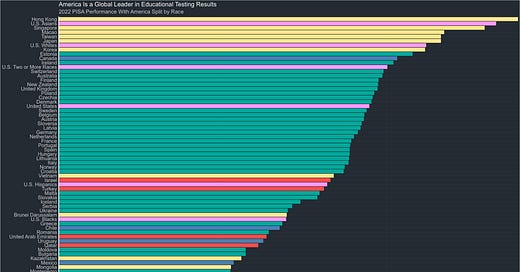When I interned at various schools in my last year of college, I noticed that a large percentage of students could not read on grade level. I’ve thought a little about what the problems are and what I would do to fix them.
For tracking purposes, students have to take exams that test their reading proficiency. I noticed that for 8th grade, around a third of the students scored a “K” meaning that they had kindergarten level reading proficiency, so essentially none. Around a third were anywhere from 1st grade to 5th, and the last third were anywhere from 0-3 grade levels behind.
Given this information, what should be done?
Why are there so many lower-scoring students
For all its flaws, national academic achievement scores. This is most clear when breaking scores down by race. This matters because many comparison countries are racially homogeneous, and on average, different racial groups tend to score higher or lower than others. The reason you want to break it down by race is because grouping everyone together and judging the US by it’s average makes it appear worse than it actually is.
How can it be the case then, that in my experience many children were illiterate? It again has to do with demographic differences in educational achievement. I worked with students of lower means, worse culture, and lower inherent ability.1 The distribution of ability is easily recognized when we talk about students with disabilities, but rarely applied to the wider population. This explains the difference between my experience and the larger population’s ability.
So in short, there are many underperforming students because there are just a lot of students in the US. Statistically, the US’ focus on rigorous standardized testing is working.
What I would do to improve the educational system
In short, I don’t know. Education is a tough thing to optimize because in the way are interest groups debating what should be taught, signaling effects due to education being directly linked to the labor market, and differences between students making it expensive to test interventions at scale.
Solving all problems is hard, but there are still some things that we can actually do.
Reinstate the No Child Left Behind Reading First Initiative to provide funding to states that implement phonics programs.
Reinstate the NCLB tutoring program.
Increase the supply of teachers by expanding the criteria to receive teaching licenses (Implement the generally understood implications of the findings of this paper).
More states adopting school choice would probably allow for more experimentation in terms of pedagogy.
Conclusion
The upshot is that there isn’t a catastrophic failure in education outcomes, but meaningful improvements from this point will likely be incremental. Gains will come from refocusing on evidence-based methods like phonics instruction and one-on-one tutoring. Expanding the teacher workforce could also help, but there’s no silver bullet for dramatically overhauling the system overnight.
It's worth noting that despite racial achievement gaps, most of the underperforming students I worked with were white. A race-conscious approach is inferior to approaches that emphasize ability regardless of race.






What’s interesting here is all your suggestions sound like they cost more money. Doesn’t the US already spend on education at a high level relative to GDP? Though I’m not sure if that stat includes higher ed.
Is there any waste in the system that could generate savings?
Are there studies on a broken windows theory theory of education? Hypothesis: A student becomes more likely to be illiterate the more illiterate classmates they have. Stupidity is contagious based upon peer pressure